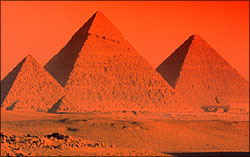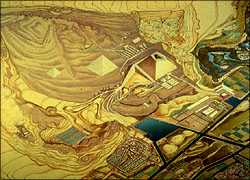
|
 Khufu's son, Khafre, who was next in the
royal line, commissioned the building of his own pyramid complex which includes
the Sphinx. Menkaure, who is believed to be Khafre's son, built the third and smallest of the
three pyramids at Giza. Giza, however, is more than just three pyramids and the
Sphinx. Each pyramid has a mortuary temple and a valley temple linked by
long causeways that were roofed and walled. Alongside Khufu and Khafre's
pyramids were large boat-shaped pits and buried boats that were presumably
meant to aid the pharaoh's journey to the afterlife. As yet, no vessels have
been found beside Menkaure's tomb. In addition, cemeteries of royal attendants
and relatives surround the three pyramids. The entire plateau is dotted with
these tombs, called mastabas, which were built
in rectangular bench-like shapes above deep burial shafts. Khufu's son, Khafre, who was next in the
royal line, commissioned the building of his own pyramid complex which includes
the Sphinx. Menkaure, who is believed to be Khafre's son, built the third and smallest of the
three pyramids at Giza. Giza, however, is more than just three pyramids and the
Sphinx. Each pyramid has a mortuary temple and a valley temple linked by
long causeways that were roofed and walled. Alongside Khufu and Khafre's
pyramids were large boat-shaped pits and buried boats that were presumably
meant to aid the pharaoh's journey to the afterlife. As yet, no vessels have
been found beside Menkaure's tomb. In addition, cemeteries of royal attendants
and relatives surround the three pyramids. The entire plateau is dotted with
these tombs, called mastabas, which were built
in rectangular bench-like shapes above deep burial shafts.
 The Nile was used to transport supplies and building materials to the pyramids.
During the annual flooding of the Nile, a natural harbor was created by the
high waters that came conveniently close to the plateau. These harbors may
have stayed water-filled year round. Some of the limestone came from Tura,
across the river, granite from Aswan, copper from Sinai, and cedar for the
boats from Lebanon. The foundations of the pyramids were laid with limestone
blocks mined by masons using copper chisels. Contrary to popular belief, the
Egyptians built the Giza pyramids up from the bedrock of the plateau, not over
a flat sandy base. Khufu, in fact, was built around a small rock knoll.
Building stones were predominantly limestone and granite, while mudbrick was
used earlier for mastabas. Mudbrick was also used to build later Middle
Kingdom Pyramids. A brilliant white limestone provided the final outer layer
for the Giza pyramids, creating what must have been an awesome if not blinding
sight to those who gazed upon these massive structures. Limestone was used for
all but the lowest course of outer casing on Khafre and the lower 16 courses of
Menkaure. These lower casings were made of granite. The Nile was used to transport supplies and building materials to the pyramids.
During the annual flooding of the Nile, a natural harbor was created by the
high waters that came conveniently close to the plateau. These harbors may
have stayed water-filled year round. Some of the limestone came from Tura,
across the river, granite from Aswan, copper from Sinai, and cedar for the
boats from Lebanon. The foundations of the pyramids were laid with limestone
blocks mined by masons using copper chisels. Contrary to popular belief, the
Egyptians built the Giza pyramids up from the bedrock of the plateau, not over
a flat sandy base. Khufu, in fact, was built around a small rock knoll.
Building stones were predominantly limestone and granite, while mudbrick was
used earlier for mastabas. Mudbrick was also used to build later Middle
Kingdom Pyramids. A brilliant white limestone provided the final outer layer
for the Giza pyramids, creating what must have been an awesome if not blinding
sight to those who gazed upon these massive structures. Limestone was used for
all but the lowest course of outer casing on Khafre and the lower 16 courses of
Menkaure. These lower casings were made of granite.
The outer casing stones have disappeared from all three pyramids except the very top
of Khafre. This is thought to be due to
 natural
erosion and human intervention; the precious white limestone was torn away from
the faces of the pyramids and used in the construction of buildings in Cairo.
There is good evidence that Khafre's bottom course of granite casing was being
stripped as early as ancient Egypt's 19th Dynasty, and as early as the 12th
century A.D., limestone was quarried from the Giza Pyramids for the construction of
buildings in Cairo. natural
erosion and human intervention; the precious white limestone was torn away from
the faces of the pyramids and used in the construction of buildings in Cairo.
There is good evidence that Khafre's bottom course of granite casing was being
stripped as early as ancient Egypt's 19th Dynasty, and as early as the 12th
century A.D., limestone was quarried from the Giza Pyramids for the construction of
buildings in Cairo.
Giza's pyramids are oriented to face the four cardinal directions: true north,
south, east, and west. Their entrances are all on the north side, and the
temples of the pyramids are on the east side. Today, through the work of
archaeologist Mark Lehner and his colleagues, a topographical and
archaeological survey of the Giza plateau is being produced by the Giza Plateau
Mapping Project.
Photos: Aaron Strong; Artwork: Mark Lehner
Pyramids Home | Pyramids | Excavation
Contents | Mail
|